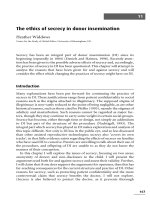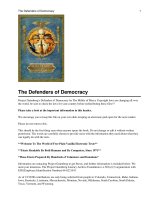The Ethics of Aesthetics pot
Bạn đang xem bản rút gọn của tài liệu. Xem và tải ngay bản đầy đủ của tài liệu tại đây (146.18 KB, 10 trang )
The Ethics of Aesthetics
Ritter, Don (2008) “The Ethics of Aesthetics.” eds. R. Adams, S. Gibson, S. Muller Arisona,
Transdisciplinary Digital Art, Berlin: Springer, pp. 5–14
© Don Ritter 2008
Don Ritter
Berlin, Germany
Abstract. The article explores the relationships between aesthetics, ethics, and
new media art by discussing the process, influences, and consequences of
aesthetic judgements. The text proposes that the aesthetic judgements of artworks
created in any medium, including new media, function as mechanisms for
propagating certain ethical values.
Keywords: aesthetics, ethics, promotion, new media art, function of art
1 Introduction
When an artwork is examined according to its mechanism, we pursue an
understanding of what it is. When an artwork is examined according to its function,
we pursue an understanding of what it does. This article will outline a perspective for
distinguishing the function from the mechanism of artworks created in any medium,
including those created with new media technologies. Using this perspective, the text
will explore the relationships between aesthetics, ethics, and new media art by
discussing how people decide that particular artworks are good, the influences of their
aesthetic judgements, and the consequences of their judgements.
2 Aesthetics
A primary goal in the field of aesthetics is to investigate aesthetic judgements, the
decisions people make when they decide “What is art?” and “What is good art?” [1]
Although some writings on aesthetics are prescriptive in their approach, this text will
not provide a precise definition of good art, nor will it advise readers to use specific
criteria for judging art. Instead, it will discuss how people make aesthetic
judgements.
The Institutional Theory of Art, set forth by George Dickie in 1974, proposed that
“works of art are art as the result of the position or place they occupy within an
established practice, the artworld.” [2] According to this theory, the established
network of curators, galleries, and museums that sell and exhibit professional
artworks are responsible for determining what is art and what is not. The
classification used within this text is derived from Dickie’s theory: a work will be
designated as an artwork according to its capacity to promote the artworld, providing
it with more prestige, power, or whatever the artworld considers valuable. Using this
classification, the specific aesthetic features within a work, its medium, and its style
are less indicative of a work being art than its capacity to promote something within
the artworld.
6 D. Ritter
A primary problem that results from using a specific aesthetic criterion for judging
the quality of an artwork is the evaluation of the criterion itself. If beauty is selected
as a primary aesthetic criterion, the evaluation of an artwork’s quality is determined
by the definition of beauty. The primary aesthetic question “What is good art?”
becomes dependent on the question “What is beauty?” The subjectivity of defining
good art is replaced with the subjectivity of defining beauty.
In this text, the subjectivity of aesthetic judgements is acknowledged by replacing
the primary questions of aesthetics with the following: "What are the criteria for
something to be art?" and "What are the criteria for something to be good art?"
2.1 The Process of Aesthetic Judgement
The process of aesthetic judgement is a conceptual model that describes how people
decide on the quality of artworks created in new or traditional media. The model
examines how people decide if artworks are good or bad, if they have high aesthetic
value or low. The model is a conceptual tool for enhancing a person’s ability to
recognize the function of aesthetic judgements. Although the model considers
aesthetic judgements to be fundamentally subjective, it outlines a general process that
can be applied to judgements of art created in any style or medium.
Some readers may argue that objectivity exists in the judgement of art because they
believe that certain aesthetic perspectives are inherently better than others, such as the
notion of “disinterested attention.” [3] This text will not present any aesthetic
perspective as being inherently better than another, but it will provide information
pertaining to why certain perspectives are portrayed as being better.
An artwork is comprised of a collection of characteristics called aesthetic features
that can influence a person’s liking or disliking of an artwork, its aesthetic value. [4]
The loudness of sound, a particular sound editing software, or a work’s production
costs can all be aesthetic features within a sound installation. A broad definition of
aesthetic features is used to support the perspective that a compositional element is
any characteristic of an artwork that can influence aesthetic judgements, including
characteristics that some writers consider to be context or extrinsic features.
The specific qualities that a person associates with good artworks are determined
by a person’s aesthetic perspective, an idiosyncratic collection of criteria that defines
which aesthetic features must be present for artworks to be judged as good. The
judgement of an artwork is dependent on its aesthetic features and the aesthetic
perspective used by a person for judging it. Using this model, disagreements on the
aesthetic value of a work are viewed as the consequences of people using different
aesthetic perspectives.
An aesthetic judgement is a decision made by an individual regarding the aesthetic
value, the quality, of an artwork. The outcome of an aesthetic judgement is expressed
through observable expressions of aesthetic judgements, such as a person speaking
positively about a work or purposely reexperiencing an artwork. Aesthetic judgements
are created by the fulfillment or lack of fulfillment of the aesthetic criteria contained
within a person’s aesthetic perspective. When a person makes an aesthetic judgement,
the fulfillment of a specific criterion does not always increase the aesthetic value of a
work. Some people may use beauty as a negative aesthetic criterion within their
The Ethics of Aesthetics 7
aesthetic perspective: the recognition of beauty within a work decreases a work’s
aesthetic value. For other persons, beauty could be a positive aesthetic criterion: the
recognition of beauty within a work increases a work’s aesthetic value. When a
positive aesthetic criterion is fulfilled, the judgement of a work moves towards a
positive aesthetic value. When a negative aesthetic criterion is fulfilled, the judgement
moves towards a negative aesthetic value. The outcome of an aesthetic judgement can
be viewed as a summation of fulfilled criteria, each criterion having a different
direction and degree of influence on a work’s aesthetic value.
2.2 Influences of Aesthetic Judgements
Imagine a person who has a large amount of knowledge about video technologies.
This person will understand the technology of a video work in more depth than
someone who does not. Consequently, aesthetic features related to video technologies
are more likely to be apparent for this person. A person with technical knowledge of
digital video formats, for example, may prefer certain formats to others. People who
lack this knowledge cannot use an aesthetic criterion that responds to this feature
because they lack the knowledge for distinguishing different digital video formats.
Similarly, a person who has knowledge about ancient mythologies might prefer works
depicting Greek deities to Roman, but a person having no knowledge of ancient
mythologies is unable to distinguish any difference between Greek or Roman.
Although it is obvious that people’s aesthetic criteria are related to their personal
knowledge, people are unable to use certain criteria if they lack knowledge
corresponding to those criteria. Because particular aesthetic features become
important to a person according to personal knowledge, a person’s liking for a
particular artwork can be based on aesthetic features that are irrelevant to someone
else. Video formats and mythology may not seem like comparable aesthetic features,
but both can be used within people’s aesthetic perspectives.
Aesthetic judgements can be influenced by any factor that affects the components
of a person’s aesthetic perspective: the limits of human perception, context,
familiarity, personal values, personal motivation, persuasion, and personal
knowledge. Personal knowledge exerts an important influence on aesthetic
judgements by determining which aesthetic features have the potential to fulfill a
person’s aesthetic criteria.
Philosophical investigations into the nature of knowledge are typically based on a
combination of logic and empiricism. Traditional approaches to epistemology usually
define knowledge as a "justified true belief." [5] A belief refers to any idea that a
person believes to be true, such as a person believing that “Vincent Van Gogh was a
painter from the nineteenth century.” A belief becomes justified when it is supported
by reason or evidence, such as documentation justifying Van Gogh’s existence and
activities as a painter. Many theories of truth have been proposed and perhaps the
most popular is the correspondence theory of truth, [6] which states that a belief is
true only if it corresponds with reality. Using this theory, the belief stated in the above
example would be true only if Van Gogh really was a painter from the nineteenth
century.
8 D. Ritter
The problematic aspect of the correspondence theory of truth is its assumption of
an objective reality. Proving the existence of an objective reality is difficult—if not
impossible—because the human sensory system is supposedly the only manner that
we have for experiencing reality. Coincidently, a similar problem pertains to theories
regarding Van Gogh’s preference for using yellow paint. One theory proposes that his
love of the liquor absinthe caused him to have yellow vision, thereby affecting his
painting. [7] The questionable aspect of this theory is its assumption that Van Gogh
had two pairs of eyes: one pair influenced by absinthe, while the other pair were
unaffected and objective. If Van Gogh’s vision was affected in a manner than caused
him to perceive certain colours of his world as yellow, his perception of paint would
be affected in the same manner. If he perceived brown trees as being yellow, and he
only had one pair of eyes, he would have also perceived brown paint as yellow.
Proving objectivity in human perception is problematic because any evidence
supporting it must presumably be interpreted through the human sensory system. In
acknowledgement of this dilemma, this text will use a phenomenological approach to
knowledge by considering truth to be based on human perception rather than
objective reality. Consequently, the term personal knowledge will refer to what a
person believes to be true, regardless of those beliefs being justified logically or
empirically.
Aesthetic perspectives are strongly influenced by personal knowledge because
people’s beliefs are often the basis for their aesthetic criteria, even when those beliefs
are inaccurate or false. A person who believes that complexity is always better than
simplicity, for example, might use an aesthetic criterion corresponding with that
belief. In order for a person to indisputably know that a belief is true, that person
needs sufficient and accurate information supporting the belief and an ability to
comprehend that information. Obtaining accurate and sufficient knowledge about any
topic can be time consuming, difficult, or expensive.
Psychologist Elliot Aronson proposes that people hold false beliefs because they
are overwhelmed with information, or because they lack the motivation and resources
to determine what is empirically true. He states that we are “cognitive misers,” that
we conserve our mental energy by “ignoring some information to reduce our
cognitive load, or we overuse other information to keep from having to search for
more.” [8]
3 Aesthetics and Ethics
Within the field of ethics, the terms moral values, moral principles, and human values
refer to the specific human behaviors that people consider desirable and good. A
person who holds honesty as a moral value, for instance, will speak honestly with all
people. The complication regarding ethics is that people often disagree about which
behaviors should be endorsed as moral values, such as abortion, capital punishment,
or same-sex marriages. Philosopher Peter Singer states, “The problem is not so much
to know ‘the difference between right and wrong’ as to decide what is right and what
is wrong.” [9]
The Ethics of Aesthetics 9
Even when people agree to adopt a specific moral value, they may disagree on
when it should be used. Deontological theories of ethics propose that people should
use moral values consistently, regardless of the consequences of their use. In contrast,
teleological theories of ethics—also called consequentialism—consider the use of
moral values to be dependent on the desired consequences. Consider the moral value
that states a person should never be aggressive with other people. If a deranged person
attacked a group of innocent people, a person who uses this value in a teleological
manner may find it ethically acceptable to aggress and stop the attack of the deranged
person. In contrast, people who use this value in a deontological manner may consider
it unacceptable to harm the attacker because they are opposed to harming people
under any circumstances.
Because of their disregard for consequences, deontological theories of ethics are
similar to inherent aesthetic theories in that they both have little or no regard for the
consequences of the experience being judged. Inherent aesthetic theories consider a
particular aesthetic perspective to be appropriate in all situations, while consequential
aesthetic theories permit the adoption of an aesthetic perspective according to the
consequences that are desired. Teleological theories of ethics are similar to
consequential aesthetic theories because they both consider consequences. The
director of a private art gallery who prefers artworks that are potentially salable when
they are intended for exhibition in the gallery, but prefers artworks that are beautiful
when they are intended for personal enjoyment is using a consequential approach to
aesthetics.
3.1 Aesthetics and Attitudes
In the field of social psychology, functional attitude theories examine the
relationships between people’s beliefs, attitudes, and behaviors. [10] Within these
theories, beliefs are defined as the concepts that people accept as being true. People
can hold beliefs on any conceivable topic, including those pertaining to themselves,
other people, tangible objects, or abstract concepts. A person, for instance, may hold
the belief that “pizza is a food.”
An attitude is defined as an evaluative judgement made by a person that expresses
a degree of liking or disliking for an attitude object. An attitude object can be any
concrete or abstract concept, such as a certain type of food, another person, a concept,
or a particular artwork. If a person holds the attitude “pizza is a good food,” the
attitude object is the pizza.
The relationships between beliefs, attitudes, and attitude objects are similar to the
relationships between aesthetic criteria, aesthetic judgements, and artworks. An
aesthetic criterion is a person’s belief, such as “good art is beautiful,” an aesthetic
judgement is a person’s attitude, such as “this artwork is good,” and the artwork being
judged is the attitude object.
The core concept of functional attitude theories is that people hold specific
attitudes because they are motivated to obtain certain goals through those attitudes.
The theories propose that a person will hold a certain attitude not because it is
objectively true, but because it serves a desired function for that person. A new media
artist who writes software for his artworks, for example, might believe and tell other
10 D. Ritter
people that “good new media art uses artist written code.” Functional attitude theories
would propose that the artist is using this particular criterion, or attitude, because he
wants other people to judge his work as being good. Similarly, a person who wants to
be considered as an intellectual may prefer a style of artwork that is considered to be
intellectual. Five general functions of attitudes have been proposed by these theories:
to seek award or avoid punishment, to obtain a perspective for understanding the
world, to defend the ego, to express personal values, or to obtain membership in a
particular social group. [10]
Functional attitude theories propose that attitudes are instrumental at providing
psychological benefits to the holders of the attitudes and that the “…primary benefit
lies not in the attitude object being evaluated but in the expression of the attitude.”
[11] This finding implies that the function of art is not determined by the specific
aesthetic features within artworks—the attitude objects—but rather through the
aesthetic judgements of artworks.
3.2 Aesthetic Judgements and Entities
The term entity refers to anything “…which is perceived or known or inferred to have
its own distinct existence (living or nonliving).” [12] An entity can be a person, a
physical object, or an intangible concept, such as integrity. A conceptual entity refers
to the existence of a specific concept, such as “good art is meaningful” or “selfishness
is good.” Conceptual entities are strengthened by becoming known and admired by
more people, and similar to beliefs, the existence of a conceptual entity is determined
by it being known by people rather than it being objectively true. Ethical values are
conceptual entities because they are essentially ideas. They differ from other
concepts, however, because they designate how people behave in relation to each
other. The notion of a conceptual entity is similar to the idea of a meme. [13]
A personal entity refers to a particular person whose existence is determined by the
presence of particular personal attributes. A social entity refers to a specific
organization of people, such as a university, a business organization, an art museum,
or a city. Aesthetic judgements are designated as mechanisms that have potential to
promote or undermine specific conceptual, personal, or social entities. Aesthetic
judgements can contribute to the strength of specific entities by enhancing their
popularity, social status, authority, financial worth, or any other characteristic
considered valuable. This perspective considers audiences to have a very important
role in the function of media because their aesthetic judgements determine which
entities will be promoted and, consequently, which values will be propagated through
media.
A social entity is an organized group of people who share similar beliefs and
values, such as particular families, cities, or business organizations. The strength of a
social entity is determined by the presence and strength of attributes that it considers
as valuable. If popularity, size, authority, and financial worth are considered
important attributes for a social entity, the enhancement of any of these features
become an increase in the entity’s strength. By using aesthetic criteria that correspond
to the values of a social entity, a person can enhance that social entity through
aesthetic judgements. A person who likes artworks exhibited at museum X promotes
The Ethics of Aesthetics 11
the concept that “museum X exhibits good artworks.” This belief strengthens the
museum financially because the person will likely pay to visit the museum.
Attendance at this museum will be increased by the person’s visits and this person
may also recommend the museum to other people, both enhancing the museum’s
popularity and financial strength.
The particular social entities being reinforced through judgements of new media
artworks are determined by the aesthetic criteria used for judging those works. If new
media artworks are judged according to technological criteria—such as the newness
of the technology—strength is provided to social entities that manufacture and sell the
newest technologies. Similarly, if new media artworks are judged according to the
presence of an established style, strength is provided to whoever acknowledges,
promotes or originated that style, including specific artists, curators, museums,
writers, and collectors. And if artworks are judged according to where they have been
exhibited, strength is provided to the galleries, museums and festivals that are
considered desirable. The positive beliefs that people hold regarding specific social
entities function as mechanisms that promote those entities.
3.3 Promotion
The term promotion is used in reference to any action that contributes to the
advancement, strength, or prosperity of a conceptual, personal, or social entity.
Paying to see a commercial film can be a promotion for the studio that made the film.
Liking minimalist art can be a promotion for the conceptual entity “minimalist art is
good.” Telling a friend that you like a specific artist’s work can be a promotion for
that artist, a personal entity. And attending an exhibition at a specific museum can be
a promotion for that museum, a social entity. Even if a person dislikes an exhibition at
an art museum, the person’s visit has contributed to the museum’s attendance records
and ticket sales. A complicated aspect of promotion is that some people may be
unaware how their actions are enhancing entities or which entities are being
promoted.
Individual persons can have different relationships with promotion: as instigators,
profiteers, carriers, or targets. Instigators of promotion are the persons or institutions
that initiate the strategy of a particular promotion. The most apparent examples of
instigators are advertising firms that are hired by manufacturers to promote their
products through advertising. Less obvious examples are news writers who promote
certain biases within newspapers and television news programs. A common term for
the instigator of a promotion is a spin doctor.
The profiteer of promotion refers to an entity that profits through a particular
promotion. Promotion can enhance an entity by providing it with more popularity,
status, revenue, or whatever is considered valuable by that entity. The profiteer and
instigator of a promotion may be the same person or organization, though it is
common for a profiteer to hire an instigator.
Carriers of promotion are persons or organizations that carry out promotions, such
as salespersons, athletes who wear corporate identities on their uniforms and
equipment, or consumers who buy t-shirts bearing the logos of commercial products.
Carriers of a promotion may not always profit from the promotion, and they may not
12 D. Ritter
always realize their function as such. Athletes who bear corporate logos are
undoubtedly aware of their function and they are probably receiving compensation as
well, but people who wear clothing emblazoned with the names of their favorite
corporations, cities, or music groups may be unaware of their function as unpaid
promoters.
When people are carriers of promotion, they can provide a promotional mechanism
in the form of spoken words, written text, articles of clothing, or whatever—including
tattoos of logos on their bodies. [14] A teenager who boasts to friends about owning a
particular brand of sneakers is a carrier of promotion for that manufacturer. Similarly,
an academic who consistently teaches and writes about a particular style of artwork is
a carrier of promotion for the entities associated with that style. Although it is
unavoidable to be a carrier of promotion, because certain entities are always promoted
through words and actions, people can consciously decide which entities they decide
to promote.
A target of promotion is the person or entity that provides a specific form of profit
to the profiteer. Voters within an election are the target of a newspaper article that
provides a favorable depiction of a political candidate, and computer consumers are
the target for a t-shirt bearing the name of a computer manufacturer.
3.5 Media Subterfuges
Media subterfuges refer to media content that is created or distributed for reasons
other than what an audience believes, or for reasons other than what is proclaimed by
the producers and promoters of the content. A common example of a media
subterfuge is a specific product appearing in a commercial film because the
manufacture of the product has paid for its inclusion, an advertising strategy called
product placement. This text proposes that the general function of all media is to
strengthen particular entities, but which entities are being strengthened will be unclear
to audiences when media subterfuges are used. Media subterfuges are often successful
because they fulfill the desires of an intended entity, such as the manufacturers of a
specific product, and also the desires of an audience.
A popular strategy for accomplishing a media subterfuge is to encourage audiences
to use the aesthetic criteria that will ensure the goal of a subterfuge. Filmgoers may be
encouraged through television talk shows to judge commercial films according to
their use of celebrity actors, which only large film studios can afford. Another
strategy for a media subterfuge is the creation of content that fulfills an audience’s
existing aesthetic criteria while concurrently fulfilling the goals of the producers or
distributors of that content. A documentary video about the impoverishment of a
particular country may appeal to audiences who hold humanistic values, but the film
may have been created to enhance the reputation of the director, to promote a political
party who funded the production, or as a mechanism for attracting large audiences
and, subsequently, large advertising revenues for the broadcasters of the video.
Although many people are aware of media subterfuges being used within
commercial media, such as product placement, its use with fine art media may be less
obvious. When an art museum exhibits particular artworks, its audience may believe
that the works are being exhibited because they are objectively good. My research
The Ethics of Aesthetics 13
interviews with curators disclosed that various reasons might exist for exhibiting
specific artworks, including nepotism, exchanging opportunities, enhancing the
reputation of the gallery, or enhancing the reputation of an institution associated with
the artist being exhibited.
As more people become aware of advertising strategies, covert forms of persuasion
have become increasingly popular, such as product placement and viral advertising.
The common feature of these and other forms of stealth advertising is that they do not
appear to be persuasion. Examples of viral advertising are certain video files that are
shared by friends through email or posted on personal websites. These videos are
often macabre, humorous or sexual, and they usually have a reference to a
commercial product, though the actual association with the manufacturer of the
depicted product is uncertain.
So the item of the day on advertising blogs everywhere has been this disturbing
viral Volkswagen ad. It shows, if you can believe it, a suicide bomber driving
up to a café in a VW Polo and trying to detonate a car bomb. But he manages to
blow only himself up—the sporty little roadster absorbs the blast, proving that
it is “small but tough.” As if we needed it, we have gotten official word that
neither VW nor any of its agencies (including DDB, its lead shop in Europe)
had anything to do with this. It is indeed a hoax. Move on, please. Nothing to
see here. Adfreak.com blog. [15]
4 Conclusion
The conclusion of this article is that aesthetic judgements of art function as
mechanisms for promoting specific conceptual, personal, and social entities. An
entity can be an abstract concept, an ethical value, a specific person, or an organized
social institution with cultural, business, or political responsibilities. The aesthetic
criteria used by people for judging artworks—rather than artworks’ aesthetic
features—determine which entities are promoted through aesthetic judgements. Some
people, however, may be unaware of which entities are being promoted through their
judgements because of a lack of knowledge or awareness, or because media
subterfuges are being used. This article has avoided stating which specific entities are
being promoted through aesthetic judgements because the intention is to provide a
perspective that enables readers to determine these relationships for themselves.
By understanding the ethical consequences of compositional decisions and
aesthetic judgements, artists and audiences can have increased responsibility for the
propagation of ethical values, the concepts that dictate which behaviors we deem
appropriate and which we do not. Without this awareness, a person might promote
any value whatsoever through aesthetic judgements. Having an awareness of the
influences and consequences of aesthetic judgements is desirable because it enables a
person to promote specific values with intention.
14 D. Ritter
Acknowledgements: This article is derived from The E Decision, a book by Don
Ritter. Funding and support was provided by Pratt Institute, The Canada Council, The
Banff Centre for the Arts, and the Zentrum für Kunst und Medientechnologie
Karlsruhe.
References
1. Morawski, S.: Inquiries into the Fundamentals of Aesthetics, MIT Press, Cambridge, pp. xii
(1974)
2. Dickie, G.: Introduction to Aesthetics: An Analytic Approach, Oxford University Press,
New York, pp. 88 (1997)
3. Dickie, G.: Introduction to Aesthetics: An Analytic Approach. Oxford University Press,
New York (1997)
4. Muelder Eaton, M.: Basic Issues in Aesthetics. Waveland Press, Prospect Heights, Illinois
(1999)
5. Audi, R. (ed): The Cambridge Dictionary of Philosophy, Cambridge University Press,
Cambridge, pp. 273 (1995)
6. Marian, D.: The Correspondence Theory of Truth. Stanford Encyclopedia of Philosophy
(2005), /> 7. Wolf, P.L.: The Effects of Diseases, Drugs, and Chemicals on the Creativity and
Productivity of Famous Sculptors, Classic Painters, Classic Music Composers, and Authors.
Archives of Pathology and Laboratory Medicine, Vol. 129, No. 11, pp. 1457-1464 (2005)
8. Aronson, E.: The Social Animal, Worth Publishers, New York, pp. 97, (2004)
9. Singer, P.: “Writings on an Ethical Life” in Moral Experts, Ecco Press, New York, pp. 5
(2000)
10. Eagly, A.H., Chaiken, S.: The Psychology of Attitudes. Harcourt, Brace, Jovanovich, Fort
Worth (1993)
11. Eagly, A.H., Chaiken, S.: The Psychology of Attitudes, Harcourt, Brace, Jovanovich, Fort
Worth, pp. 483 (1993)
12. entity. Dictionary.com. Princeton University,
/>13. Dawkins, R.: The Selfish Gene. Oxford University Press, Oxford (1976)
14. Kahney, L.: 2002. Tat’s the Way Mac Heads Like It. Wired.com (2002),
/>15. Nudd, T.: “Viral suicide-bomber viral spot a hoax” Adfreak.com blog, (January 18, 2005),
/>









